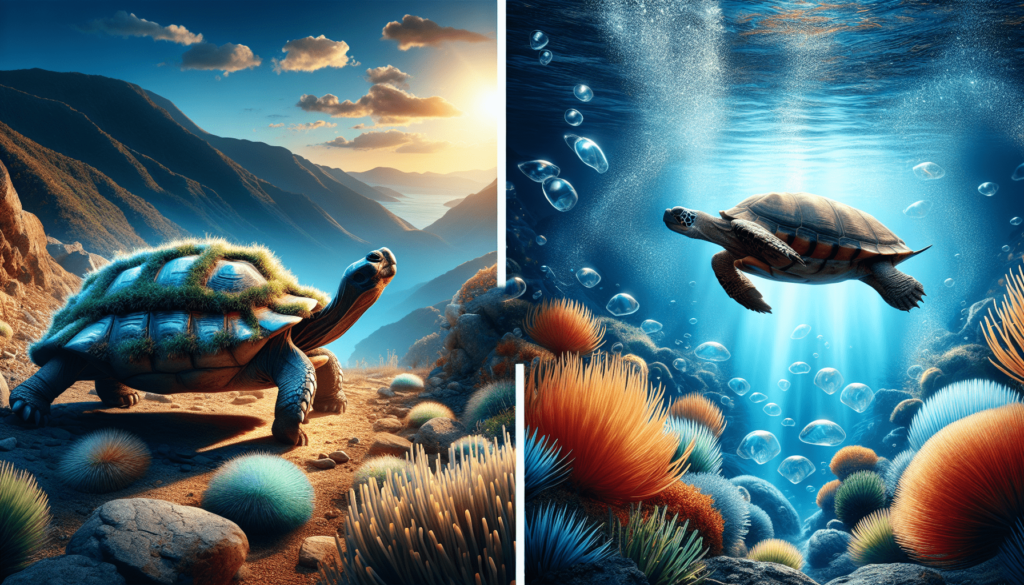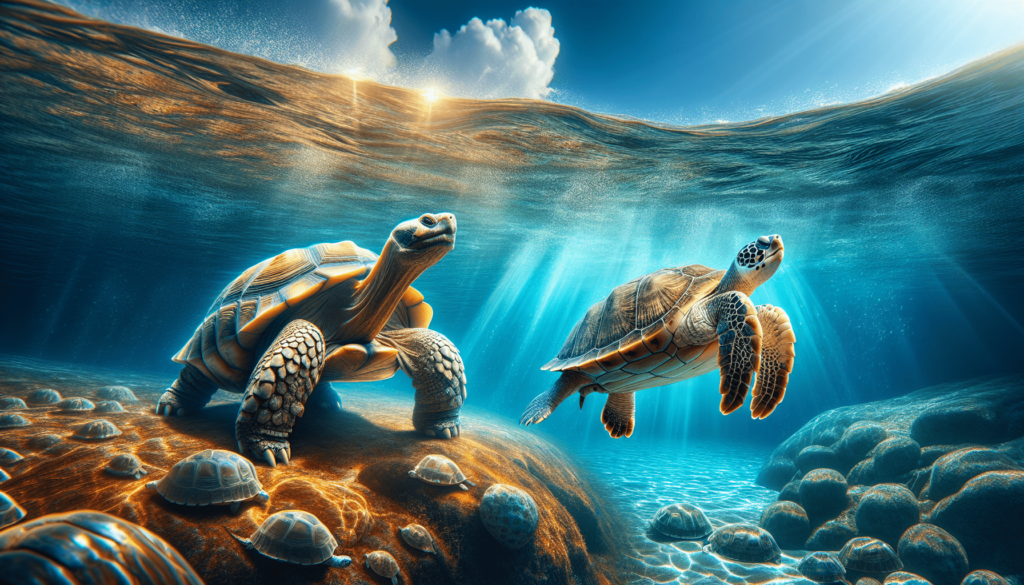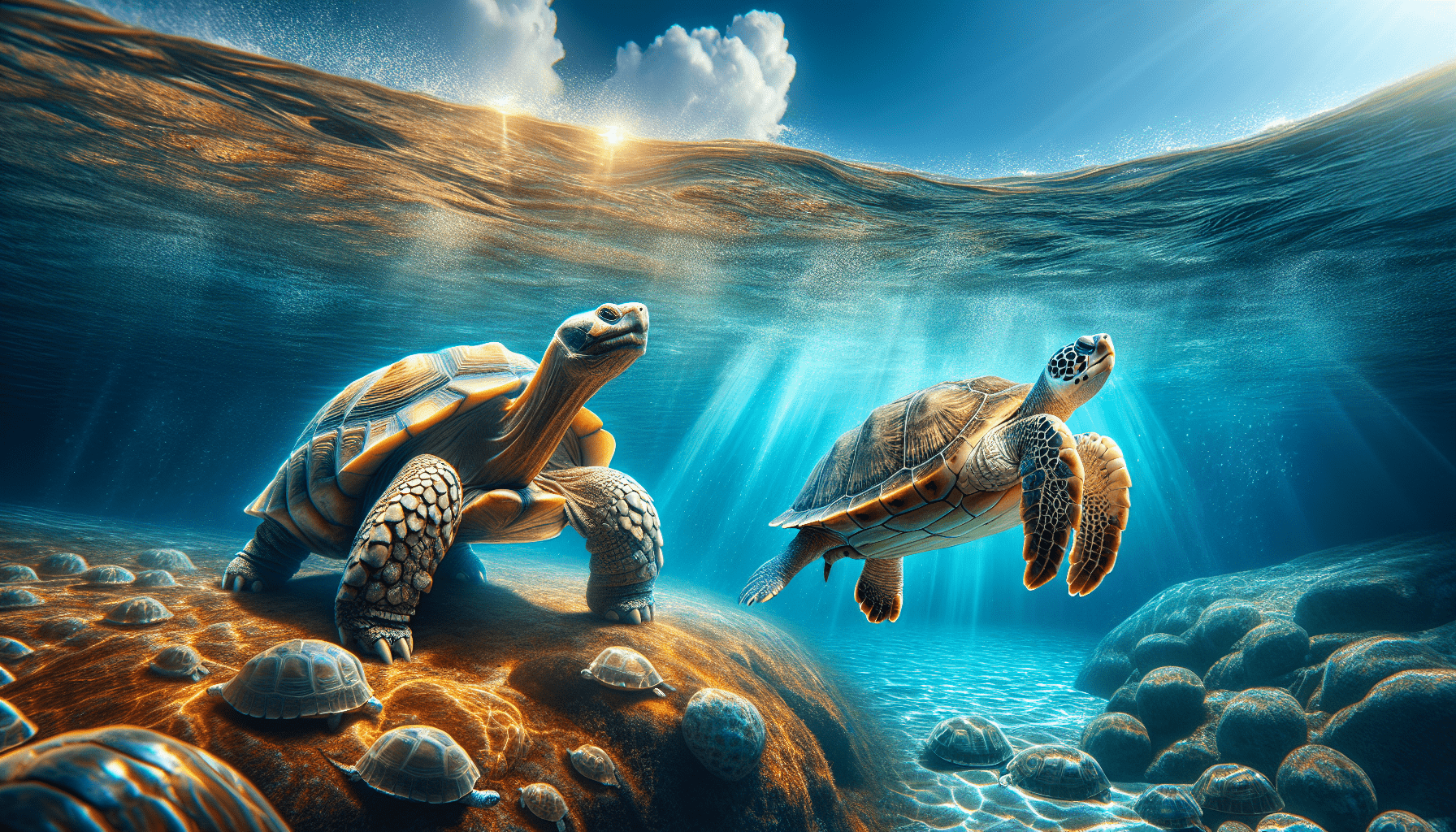Imagine a slow and steady world inhabited by two remarkable creatures – the tortoise and the turtle. Both are incredible reptiles that have gracefully roamed our planet for centuries, capturing the hearts of many with their unique characteristics. But have you ever wondered, who has the upper hand when it comes to longevity? In this article, we embark on an exciting journey to explore the lifespans of these magnificent beings, as we uncover the answer to the age-old question: who lives more, tortoise or turtle? Prepare to be amazed as we unravel the secrets of these fascinating creatures and unveil the winner of this remarkable endurance race.
Introduction
Welcome to this comprehensive article all about tortoises and turtles! In this friendly guide, we will explore the lifecycles, habitats, food habits, predators, longevity, environmental factors, threats, and conservation efforts for both tortoises and turtles. We will also compare the physical and behavioral differences between these fascinating creatures and discuss their mortality rates. So, let’s dive in and learn more about these incredible reptiles!
Lifecycle
Tortoise lifecycle
Tortoises have a unique and interesting lifecycle. It starts with the hatching of eggs, which takes place in a carefully chosen nesting site. The female tortoise goes through a process called oviposition, where she digs a hole in the ground to deposit her eggs. Once laid, the eggs are covered and left to incubate for several months. After this incubation period, tiny tortoises, known as hatchlings, emerge from the eggs. They are fully independent from birth and begin their journey into adulthood.
Throughout their lifecycle, tortoises undergo gradual growth, which is dependent on their species and environmental conditions. The growth rate may vary, but typically, tortoises take several years to reach sexual maturity. During this time, they go through various stages of development, shedding their outer skin layers and growing new ones. Tortoises can live for several decades or even over a century, making them long-lived creatures.
Turtle lifecycle
Turtles, similar to tortoises, also have an intriguing lifecycle. It all begins when female turtles come ashore to lay their eggs. They select a suitable nesting site, typically a sandy beach, and dig a nest for their eggs. Once the eggs are laid, the female turtle carefully covers them with sand and returns to the sea. The eggs are left to incubate for a certain period, depending on the species.
After the incubation period, the hatchlings emerge from their eggs and instinctively make their way towards the water. This journey is filled with challenges and risks, as many predators await them on the beach. The survival rate of turtle hatchlings is relatively low, with only a small percentage making it to adulthood. However, those that do survive and reach maturity are known to live for several decades, with some species having lifespans of 50 years or more.

Habitat
Tortoise habitat
Tortoises are primarily terrestrial creatures, with habitats that vary depending on the species. They can be found in various regions worldwide, including deserts, grasslands, forests, and even mountains. Some tortoises prefer arid environments and have adapted to survive in dry and harsh conditions. On the other hand, certain species thrive in more tropical or subtropical areas with abundant vegetation and moisture.
The ideal tortoise habitat includes areas with ample vegetation for grazing, access to freshwater sources, and a stable climate that provides suitable temperatures year-round. These reptiles often require a wide range of habitats and are known to migrate within their territory in search of food and better living conditions.
Turtle habitat
Unlike tortoises, turtles spend a significant portion of their lives in water. They are adapted to aquatic environments and can be found in oceans, seas, rivers, lakes, and even swamps. Some turtle species are strictly marine, while others inhabit freshwater bodies. Certain species, like the loggerhead turtle, have a migratory nature, traveling thousands of miles between feeding and nesting areas.
Turtles require suitable habitats with access to food sources, nesting sites, and areas for basking to regulate their body temperature. Coastal areas are crucial for marine turtles, as they provide feeding grounds and nesting beaches. Freshwater turtles, on the other hand, seek habitats with slow-moving water, abundant vegetation, and suitable spots for basking.
Food Habits
Tortoise food habits
Tortoises are herbivores, meaning they primarily consume plant matter. Their diet usually consists of grasses, leaves, flowers, and fruits. Different tortoise species have varying dietary preferences and adaptations to their environments. Some are specialized grazers, while others have a broader diet and consume a variety of vegetation.
Due to their slow metabolism, tortoises are capable of efficiently extracting nutrients from their food. They have strong jaws and sharp beaks that enable them to tear leaves and browse on tougher plant materials. Tortoises also have a specialized gut that allows them to break down and ferment plant fibers, extracting maximum nutrition from their diet.
Turtle food habits
Turtles have diverse food habits depending on their species and habitat. The diet of marine turtles mainly consists of sea grasses, algae, jellyfish, and other invertebrates found in the ocean. They use their strong jaws and sharp beaks to crush and consume their prey. Some species, such as the green turtle, have specialized adaptations that allow them to efficiently feed on seagrasses.
Freshwater turtles have a varied diet that includes aquatic plants, small fish, crustaceans, and insects. They use their hooked jaws to capture and consume their prey. These turtles are known to be opportunistic feeders, adapting their diet based on the food sources available in their environment.

Predators
Tortoise predators
While tortoises may seem like armored giants, they have their share of predators to contend with. In their natural habitats, tortoises face threats from predators such as large birds of prey, mammals like foxes and coyotes, and even some reptiles. Juvenile tortoises are especially vulnerable to predation, as their small size makes them easier targets.
To protect themselves, tortoises have evolved various defense mechanisms. Their tough, dome-shaped shells provide excellent protection against most predators, acting as a shield for their vulnerable body parts. Additionally, tortoises can retract their head, legs, and tail into their shell, making it harder for predators to access them.
Turtle predators
Turtles also face numerous predators throughout their lifecycle. Hatchlings, in particular, face significant risks as they emerge from their nests and make their way to the water. Various animals, including birds, crabs, raccoons, and even fish, prey on turtle hatchlings. Adults are less susceptible to predation but may still encounter threats such as sharks, large fish, crocodiles, and some mammalian predators like jaguars.
To defend themselves, turtles rely on a combination of their protective shells, strength, and agility. While their shells offer excellent protection, most turtles have the ability to retract their head and limbs into their shells, making them less accessible to predators. Some turtles, like the snapping turtle, have powerful jaws and can deliver a strong bite if threatened.
Longevity
Tortoise longevity
One of the fascinating aspects of tortoises is their exceptional longevity. Among reptiles, tortoises are known for being some of the longest-lived creatures on Earth. Some species, such as the Galapagos tortoise, have been documented to live well over a hundred years, with a few even reaching the remarkable age of 200 years.
The longevity of tortoises can be attributed to their slow metabolic rate and their ability to conserve energy. This, combined with their robust shells, efficient digestive systems, and adaptations to survive in harsh environments, allows them to thrive over an extended lifespan. With proper care in captivity, tortoises have been known to live even longer than their wild counterparts.
Turtle longevity
While turtles may not have the same extreme longevity as tortoises, they can still live for several decades. Lifespan varies among turtle species, with some living around 20 to 30 years, while others have lifespans that can exceed 50 years. Factors such as species, habitat, diet, environmental conditions, and human interference can all influence the longevity of turtles.
Marine turtles tend to have longer lifespans compared to freshwater turtles. This can be attributed to their more stable and less risky environment. However, threats such as pollution, fishing gear entanglement, and habitat destruction can significantly impact the survival and longevity of turtles in both marine and freshwater ecosystems.
Environmental Factors
Tortoise environmental factors
Tortoises are influenced by various environmental factors that affect their overall health and survival. Temperature, humidity, rainfall, and the availability of food and water greatly impact their well-being. Tortoises are ectothermic, meaning their body temperature is regulated by external heat sources. They rely on basking in the sun or seeking shade to adjust their body temperature accordingly.
Some tortoise species also rely on burrows, which provide protection from extreme temperatures, predators, and other environmental extremes. These burrows can be crucial for maintaining suitable conditions during harsh weather or seasonal changes. Additionally, tortoises require access to freshwater sources for drinking and bathing.
Turtle environmental factors
Turtles are highly influenced by their environmental conditions, both in water and on land if they come ashore. Water temperature, salinity, quality, and availability of food sources all play essential roles in their survival and well-being. Turtles are ectothermic as well and rely on external heat sources, such as the sun, to regulate their body temperature.
Coastal development, pollution, climate change, and habitat loss pose significant threats to turtles and their environmental factors. The alteration of nesting beaches, destruction of coral reefs, and increased pollution of marine ecosystems can disrupt the delicate balance required for their survival. Conservation efforts aim to protect and restore these habitats and ensure the environmental factors necessary for turtle populations to thrive.
Threats and Conservation
Threats to tortoises
Tortoises face numerous threats to their populations. Habitat destruction due to urbanization, agriculture, and logging is a significant concern. Human activities have also led to the introduction of invasive species, which compete for resources and prey on tortoises and their eggs.
Illegal pet trade is another threat, as tortoises are often sought after as exotic pets. Overharvesting for consumption and traditional medicine practices also contribute to declines in tortoise populations. Climate change and habitat fragmentation further exacerbate these threats, making conservation efforts crucial for their survival.
Threats to turtles
Turtles, like tortoises, face a wide range of threats to their survival. The destruction of nesting beaches due to coastal development, predation of eggs by humans and animals, accidental capture in fishing gear, and pollution of marine habitats are primary concerns for their populations.
Climate change poses additional risks, as rising temperatures affect nesting sites and alter ocean currents, impacting the distribution of food sources. Light pollution on nesting beaches can disorient hatchlings, leading them away from the ocean, resulting in high mortality rates. Conservation efforts aim to mitigate these threats and ensure the continued existence of turtle species.
Conservation efforts for tortoises
Conservation initiatives for tortoises focus on protecting and restoring their habitats, implementing laws and regulations to control the illegal pet trade, and raising awareness about the importance of preserving these unique creatures. Captive breeding programs have been successful in replenishing wild populations and ensuring genetic diversity.
Conservation organizations work closely with local communities, governments, and researchers to study and monitor tortoise populations. Through education and community involvement, efforts are made to reduce human-wildlife conflicts and promote sustainable practices that benefit both tortoises and their habitats.
Conservation efforts for turtles
Conservation efforts for turtles are multifaceted and involve international collaborations and organizations working at various levels. Projects often focus on protecting nesting beaches, implementing fishing regulations, reducing plastic pollution, and advocating for the establishment of marine protected areas.
Research and monitoring programs help gather data on turtle populations and track their migrations. These efforts aim to better understand their life cycles, behavior, and the threats they face. Community engagement and education play a vital role in conservation efforts, as they raise awareness about the importance of turtle conservation and foster a sense of responsibility towards these incredible creatures.
Comparison
Physical differences
Tortoises and turtles exhibit distinct physical differences. Tortoises have sturdy, domed shells adapted for life on land, with the ability to withdraw their head, legs, and tail into their shells. Their limbs are typically short and sturdy, adapted for walking on land, and their feet have strong, clawed toes.
Turtles, on the other hand, have streamlined shells, often flatter and lighter than those of tortoises. Their limbs are modified into flippers, allowing them to maneuver efficiently through water. Turtles have webbed feet, which aid in swimming, and their shell structure is more flexible to enhance agility in aquatic environments.
Behavioral differences
Behaviorally, tortoises and turtles also display unique characteristics. Tortoises are generally more docile and slower-moving than turtles. They spend most of their time on land, grazing, basking, and exploring their surroundings. Tortoises are solitary animals, often seeking solitary lives except during mating season.
Turtles, on the other hand, exhibit more social behavior, especially during nesting season when females congregate on beaches to lay their eggs. Some turtle species migrate long distances, displaying remarkable navigation abilities. Turtles also spend a significant amount of time in water, using their aquatic habitats for feeding, mating, and resting.
Mortality rates
Mortality rates differ between tortoises and turtles, primarily due to their varied lifespans, habitats, and environmental factors. Tortoises generally have lower mortality rates once they reach adulthood, thanks to their sturdy shells, excellent adaptations, and long lifespans. However, they face higher risks during their early life stages due to predation and habitat challenges.
Turtles, particularly hatchlings, face higher mortality rates due to numerous threats such as predation, habitat loss, pollution, and accidental capture in fishing gear. This high mortality rate is partially responsible for their reproductive strategy of laying large numbers of eggs to increase the chances of survival. However, those that survive and reach maturity have the potential to live for several decades.
Conclusion
In conclusion, both tortoises and turtles are remarkable creatures with unique lifecycles, habitats, food habits, predators, and longevity. While tortoises are land-dwelling herbivores known for their long lifespans and sturdy shells, turtles are adapted to various aquatic environments and face different threats and challenges. The conservation efforts in place aim to protect and preserve these incredible reptiles, ensuring their survival for generations to come. Let us continue to appreciate and safeguard these fascinating species, appreciating their differences and marveling at their extraordinary resilience.
